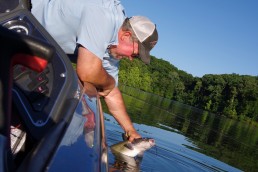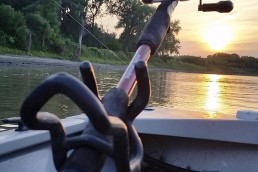Spider-rigging for Catfish
SHARE THIS POST
I began spider-rigging several years ago to target crappies in the winter. I eventually found that spider-rigging worked great all season long. Soon, I was prowling the shallows for springtime crappies. As the spring spawn began to wind down, I would catch catfish with my spider-rig setup. I’d finally give up on the crappies as they moved out to deeper water and target catfish as they moved up to spawn.
Catfish spawn a little later than crappies. This creates a great overlap for the multispecies angler. When the crappie bite slows, the catfish bite will begin to get hot. It took a few seasons, but I finally decided I was going to try targeting catfish by spider-rigging. The tactic worked. Many catfish, mainly channel catfish, have been put in the freezer using the spider-rig method. Here are a few changes I make to spider-rig for catfish.
Location and tactics
Channel catfish love shallow coves with deadfalls and brush piles to spawn in. They will also seek rocks to spawn in. Small chunk rocks, often referred to as riprap, are a great place to find spawning channel catfish. When the water temps hit the upper 60s and the crappies have left the shallows, start looking for channel catfish to move up into and around these areas. They will be moving up and down the banks searching for food in preparation for the spawn that’s coming.
The spider-rig setup allows you to slowly move around in these bays, intercepting these cruising fish. These early season catfish can be aggressive. There is no mistaking when you get a bite. Very seldom will you have a bite without a hookup. Just lift up on the rod like you would a crappie. Keep tension on the line and lift straight up. Have the net ready and dip it up when it reaches the surface. I like to spread my rods out more when catfishing because they can put up a pretty good fight. By spreading the rods, you can eliminate some hassles of the catfish tangling into another line.
The rod and reel
When I first started spider-rigging for catfish, I just used my long crappie poles and it worked fine for those 2- and 3-pound eaters that I was after. However, I would hook one or two good-size catfish and couldn’t get them in on crappie tackle. I finally decided to get a few rods that could get those big ones in the boat when I hooked them. I made room on my rod rack for a few more rods. (Much to my wife’s chagrin, until she had those delicious catfish fillets all winter long.)
A long rod, when spider-rigging for crappies, helps keep you and the boat away from the catfish. That way you don’t spook them as you move along. The 10 to 12-foot rod will help you ease up to brush piles and shallow riprap where catfish are prowling, looking for optimum spawning sites. The difference is in the power of the rod. I like to use a medium-power rod when spider-rigging for catfish. As mentioned above, the lighter rods work great for the smaller fish and are loads of fun to catch them on. However, a medium-power rod just gives you a better chance of landing a big catfish if one happens along.
The reel for this tactic can be a simple spinning reel or baitcasting reel. No need to get too fancy. Save your money for a quality rod and terminal tackle. You are only letting out line from the reel to the depth you want to fish. A good drag is not that important, either, when spider-rigging for catfish. I rig with a heavy enough line that I can tighten my drag all the way down and let the rod and landing net do all the work.
Are you enjoying this post?
You can be among the first to get the latest info on where to go, what to use and how to use it!
Spool your reel with heavy line. Catfish are not line shy. Use 14- to 20-pound-test monofilament and, with the long rods, you won’t break anything off. If you do hook a giant, you will have time to loosen the drag so it can run. I like to use braid in 30-pound test and even heavier. Braid costs a little more, but it should last several seasons if kept out of the sun.
Terminal tackle
Catfish have a very tough mouth, especially those bigger cats. A good, sharp hook is a must for accomplishing good hook penetration to land your catfish. The rig I like to use is very similar to the rigs for crappies, just heavier. Start with an egg sinker. Thread your line through the sinker, then add a bead, then a rubber bobber-stop. The bead will keep the sinker from sliding over your knot and swivel. Rubber bobber-stops will protect your knot from the bead sliding down onto it.
The swivel is tied on next. Channel catfish love to roll while you fight them. While the regular barrel swivels work, I prefer a rolling swivel like the VMC Rolling Swivels. Regular barrel swivels are a little more exposed to trash interfering with their function. Grass and moss can get on the swivel and it won’t function properly when you most need it to. The slime from the catfish as it rolls during the fight can also keep the swivel from spinning.
There are so many hooks on the market now, sometimes it can get overwhelming trying to pick the best one for your application. For this application, a good, sharp octopus-style hook—like the Gamakatsu Octopus/Circle Hooks. The octopus/circle hook isn’t as round as the true circle hook. I like these any time I’m manning the rods and can set the hook or at least apply pressure to secure a good hookup. These hooks come sharp from the factory, but make sure they stay that way. A sharp hook will help you land more catfish.
Baits
There are many baits that work for channel catfish. Chicken livers are hard to beat and will stay on your hook, since there is no casting involved. Get fresh livers, if you can. Fresh livers are tougher than frozen livers and are firmer. This helps the liver stay on the hook better. Fresh livers are also a little less messy. Frozen livers tend to be a little mushy and tend to get a little messier. The main problem with chicken livers is they can mess up a nice boat. Keep a towel handy and you will keep the mess at a minimum.
Cut-bait is another great bait. Cut-bait can be any legal baitfish you have on hand. Catfish are not picky eaters. I like to use either shad or bluegill, where legal, for my cut-bait offering. Cut-bait can be prepared ahead of time and placed on ice. This will keep the mess down considerably and keeps the cut-bait fresh. I prefer fresh to rotten. Not that fresh works better, just that I don’t like the smell and mess that the rotten baits tend to create.
Spider-rigging is a great way to spend the day or night catching those delicious catfish that prowl the shallows during the early summer. Leave that spider-rigging setup on your boat and, with a few changes to your tackle and bait, you can be enjoying another few weeks of spider-rigging and fresh fish for dinner.
MWO
SHARE THIS POST
Did you enjoy this post?
You can be among the first to get the latest info on where to go, what to use and how to use it!



